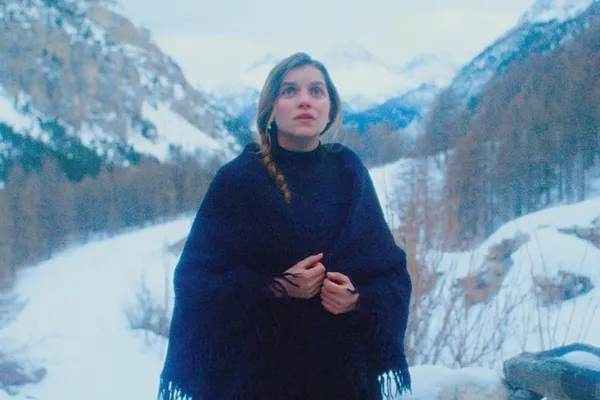Eye For Film >> Movies >> The Girl In The Snow (2025) Film Review
The Girl In The Snow
Reviewed by: Marko Stojiljkovic

Vicious wind howling, a bit of abstract neo-folk music, utter darkness broken only by some distant torchlights. That is what we hear and see at the very beginning of the Cannes Directors’ Fortnight entry The Girl in the Snow. It is a feature debut by Louise Hémon, so far best known for her short and mid-length documentaries. It should not come as too much of a surprise to learn that the story is rooted in actual events, stemming from the filmmaker’s own family history.
The strong symbolism of the opening shot probably stands for the way the protagonist of the film, the young, idealistic, even a bit zealous teacher Aimée Lazare (Galatea Bellugi) sees herself coming to the environment. We are about to see that environment shortly, in brighter but still dim lighting, as she settles into her modest accommodation and starts reading Descartes in the candlelight. It is wintertime in the late 19th century, and the place is a secluded hamlet, somewhere deep in the Alps. Judging by the surroundings and the lack of utilities, seen next day in broad daylight, one might assume that time stopped there sometime in the middle ages and that Aimée brings enlightenment in the form of her knowledge of proper French language – the villagers speak their own dialect of Occitanian – geography beyond the terms of “California” and “Algeria”, where some of the villagers went but never returned to report about, as well as the hygiene.
Her efforts are, however, meet with the locals’ superstitions that exceed the level of scepticism. For them she might as well be a colonial oppressor, and not the well-meaning, educated and emancipated woman from “the big world”. Lead by the elder women, they are convinced that removing the crust of dirt on the head exposes brain to illness, that the window of the room where the deceased is placed should be left open so the soul can exit, and that their folklore would be lost for them once it is “captured” in writing by an outsider. It is safe to assume that if anything went wrong, it would be regarded as her fault. And when the two village hunters who were the only ones who were nice to her, Énoch (Matthieu Lucci) and Pépin (Samuel Kircher), disappear in the avalanche only shortly after they encountered her in a certain way, we can be convinced that our assumption was right.
If we had some genre hopes from the beginning, be it a female update to Fabrice Du Welz’s Calvaire, an ethno-anthropological horror along the lines of Robert Eggers’ The Witch or last year’s The Devil’s Bath, by Veronika Franz and Severin Fiala, or at least an Alpine western, we should have toned down our expectations early on. Hémon pretty much stays within the borders of a period drama, although observed with a documentarian’s eye. Although, there are some echoes of a backwoods noir, mainly regarding the protagonist’s navigation of the social landscape, of folk horror in the way the villagers act towards their traditions, but with a very light touch, while also some “spaghetti western” Enio Morricone-lite infusions can be noted in Émile Sornin’s soundtrack.
The Girl In The Snow is a handsome piece of cinematic work, thanks to cinematography by Marine Atlan that utilises the lighting contrasts to perfection and with an awareness for positioning the characters in the film’s dramaturgy. The seemingly simple, but period-faithful production design by Anna Le Mouël and costumes by Joana Georges Rossi are also spot on. The actors, both professional and non-professional, should be commended as well: Galatea Bellugi, of Gloria! (2024) and The Taste Of Things (2023) fame turns into a proper star, Lucci, Kircher and an array of first-timers deftly follow her cues, while the filmmaker’s light touch with them suits the purpose.
There are certain issues that keep The Girl In The Snow from shining way brighter than it does. The notion that women are the fiercest keepers of traditions – yeah, the patriarchal ones – is not that new any more. Also the mandatory anti-colonial dogma dictates the filmmaker should show some sympathy for the village folk and their bizarre beliefs and amenities, which does not feel sincere nor functional for the film, as it lets the stark contrast established by the visuals go to waste. Finally, the biggest problem is a structural one: the exposition stretches over two-thirds of the movie and has its fair share of repetitions and underlining of the obvious, and, by the time the plot “thickens”, the viewers already feel a bit sedated.
It is a pity that The Girl In The Snow is not as packed and as eventful as it could be because in that way it could be a truly captivating viewing experience, as opposed to a piece of festival-friendly mainstream arthouse. But despite its faults, it still qualifies as an intriguing debut that lets us see the genesis of a new filmmaker with her own voice.
Reviewed on: 17 May 2025















